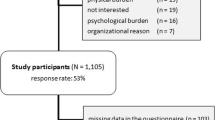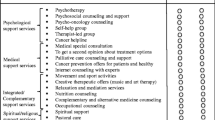Abstract
This was a cross-sectional study to examine the association between anxiety, depression and quality of life and the use of complementary and alternative medicine. Anxiety and depression was measured using the Hospital Anxiety and Depression Scale (HADS), and quality of life was measured using the global quality of life subscale selected from the European Organization for Treatment and Research of Cancer (EORTC) quality of life core questionnaire (QLQ-C30). In all, 177 breast cancer patients were studied, and 32% (n=57) reported that they used or were using complementary medicine. Users and nonusers did not differ significantly in almost all variables studied, with the exception of duration of their diagnosis. The most commonly used complementary medicine was prayer and spiritual healing (n=45, 73.8% of responses). Performing the logistic regression analysis controlling for age, marital status, educational level, knowledge of diagnosis, time since diagnosis, global quality of life, depression, and anxiety scores, the results indicated that the use of complementary medicine among breast cancer patients was associated with sever depression (odds ratio 2.49, 95% CI 1.06–5.89, P 0.04). The other variables studied did not show any significant results. The study findings confirm that the use of complementary medicine is more common among depressed breast cancer patients and might be a marker of greater psychological distress in this group of patients.
Similar content being viewed by others
References
Ashikaga T, Bosompra K, O’Brien P, Nelson L (2002) Use of complimentary and alternative medicine by breast cancer patients: prevalence, patterns and communication with physicians. Support Care Cancer 10:542–548
Burstien HJ, Gelber S, Gundagnoil E, Weeks JC (1999) Use of alternative medicine by women with early-stage breast cancer. N Engl J Med 340:1733–1739
Cassileth BR, Schraub S, Robinson E, Vickers A (2001) Alternative medicine use worldwide. Cancer 91:1390–1393
Correa-Velez I, Clavarino A, Barnett AG, Eastwood H (2003) Use of complementary and alternative medicine and quality of life: changes at the end of life. Palliative Med 17:695–703
DiGianni LM, Garber E, Winer EP (2002) Complementary and alternative medicine use among women with breast cancer. J Clin Oncol 20 [Suppl 18]: 34s-38 s
Henderson JW, Donatelle RJ (2004) Complementary and alternative medicine use by women after allopathic treatment for breast cancer. Altern Ther Health Med 10:52–57
Kolstad A, Risberg T, Bremnes Y, et al (2004) Use of complementary and alternative therapies: a national multicentre study of oncology health professionals in Norway. Support Care Cancer 12:312–318
Lengacher CA, Bennett MP, Kip KE, Keller R, LaVance MS, Smith LS, Cox CE (2002) Frequency of use of complementary and alternative medicine in women with breast cancer. Oncol Nurs Forum 29:1445–1452
Montazeri A, Harirchi I, Vahdani M, Khaleghi F, Jarvandi S, Ebrahimi M, Haji-Mahmoodi M (1999) The EORTC Quality of Life Questionnaire: translation and validation study of the Iranian version. Support Care Cancer 7:400–406
Montazeri A, Vahdaninia M, Ebrahimi M, Jarvandi S (2003) The Hospital Anxiety and Depression Scale (HADS): translation and validation study of the Iranian version. Health and Quality of Life Outcomes 1:14 [http://www.hqlo.com/content/1/1/14]
Risberg T, Jacobsen BK (2003) The association between mental distress and the use of alternative medicine among cancer patients in North Norway. Qual Life Res 12:539–544
Risberg T, Kaasa S, Wist E, Melsom H (1997) Why are cancer patients using non-proven complementary therapies? Eur J Cancer 33:575–580
Sibbritt D, Adams J, Easthope G, Young A (2003) Complementary and alternative medicine (CAM) use among elderly Australian women who have cancer. Support Care Cancer 11:548–550
Sollner W, Maislinger S, DeVries A, Steixner E, Rumpold G, Lukas P (2000) Use of complementary and alternative medicine by cancer patients is not associated with perceived distress or poor compliance with standard treatment but with active coping behavior: a survey. Cancer 89:873–888
Vickers A (2004) Alternative cancer cures: ‘unproven’ or ‘disproven’. CA Cancer J Clin 54:110–118
Author information
Authors and Affiliations
Corresponding author
Additional information
The preliminary results of this study was presented at the 4th European Breast Cancer Conference, Hamburg, Germany, 16–20 March 2004
Rights and permissions
About this article
Cite this article
Montazeri, A., Sajadian, A., Ebrahimi, M. et al. Depression and the use of complementary medicine among breast cancer patients. Support Care Cancer 13, 339–342 (2005). https://doi.org/10.1007/s00520-004-0709-z
Received:
Accepted:
Published:
Issue Date:
DOI: https://doi.org/10.1007/s00520-004-0709-z




